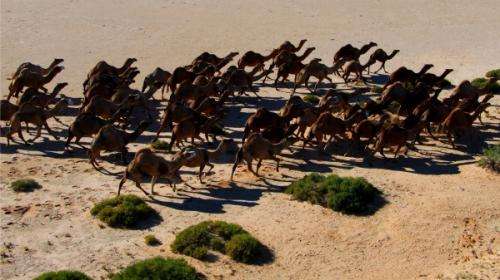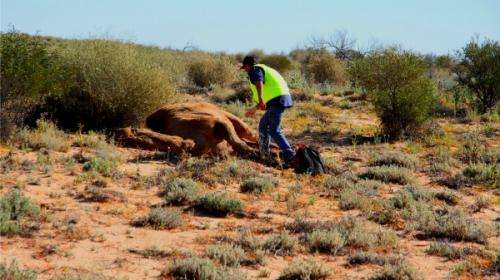Helicopter shootings provide humane end for camels

The first study to assess animal welfare outcomes from helicopter shootings has shown the method is a humane tool for reducing overabundant camel populations across Australia.
Ecotone Wildlife Veterinary Services consultant veterinarian Jordan Hampton was engaged as an independent auditor to perform field work and collect data for the research.
Mr Hampton says the best way to ensure the camels are killed quickly is through rigorous selection and training of the shooters.
"Animals that suffer a protracted death are considered to suffer a poor animal welfare outcome," he says.
"I advocate auditing shooting performance as this is the most important determinant of these outcomes.
"Shooter performance is affected by a combination of shooter skill level, training, equipment and fatigue level."
The study, which was initiated by the Australian Feral Camel Management Project (AFCMP) and involved Murdoch University, set out to ensure high animal welfare standards were maintained for all feral camel removal methods.
The project, completed at the end of 2013, aimed to reduce the national feral camel population size due to their negative impact on environmental, agricultural and cultural assets in Australia's arid zone.
"Without intervention, it was predicted the national population size would soon expand into the millions, with accompanying environmental impacts and increased difficulty achieving effective population reduction," Mr Hampton says.

The study's methods were adapted from those developed by independent international observers auditing animal welfare outcomes from whale harvesting operations.
During the study, seven post-mortem studies and one ante-mortem study were undertaken during routine helicopter shooting programs.
Researchers studied time to death, instantaneous death rate, wounding rate and location of bullet wound tracts.
The wounding rate was 0.4 per cent and the killing efficacy of the technique was 99.6 per cent. Mean time to death was four seconds and mean instantaneous death rate was 83 per cent.
"This method produces a very low wounding rate and rapid time to death," Mr Hampton says.
"Regression analysis revealed the identity of the shooter and the nature of the local vegetation, which contributes to visibility, were the most important factors associated with the animal's death."
Even though there was a low incidence of animals that did not suffer an instantaneous death or were wounded but not killed, helicopter shooting was found to provide an effective landscape scale tool for the removal of large herbivores.
"In the absence of accessible control methods, effective wildlife management is not achievable," Mr Hampton says.
More information: "Quantitative analysis of animal-welfare outcomes in helicopter shooting: a case study with feral dromedary camels (Camelus dromedarius)," Wildlife Research 41(2) 127-135 DOI: 10.1071/WR13216
Provided by Science Network WA


















